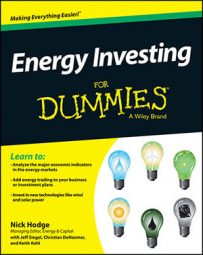Although thousands of mutual funds are floating out there, the following are among the top-ranked energy equity funds available, using a combination of ratings from multiple agencies.
Those ratings take into account risk-adjusted historical returns, the fundamentals of the underlying holdings of a fund, tax efficiency, and other factors. The information included about each fund gives you a sense of its longevity, costs, and size. Optimally, you’re looking for a fund that has the longest history of success, with the lowest costs and largest assets.
Everything in life is a trade-off, though, so you want to look for funds that have the best blend of these features.
Name: Integrity Williston Basin/Mid–North America Stock Fund Class A
Ticker: ICPAX
Fund start date: April 5, 1999
Category: Equity Energy
Total assets: $548 million
Expense ratio: 1.44%
Dividend/annual yield: N/A
Top five holdings: National Oilwell Varco, Kodiak Oil & Gas, Halliburton, Oasis Petroleum, Whiting Petroleum
Description: According to the Integrity Funds prospectus, this investment seeks long-term capital appreciation. The fund normally invests at least 80 percent of its net assets in stock of domestic and foreign issuers that are participating or benefiting from the development of the resources in the Williston Basin and/or Mid–North America area. It may not invest in companies that have recently commenced operations and don’t have significant revenues.
Name: Putnam Global Energy Fund
Ticker: PGEAX
Fund start date: December 18, 2008
Category: Equity Energy
Total assets: $19 million
Expense ratio: 1.69%
Dividend/annual yield: 0.71%
Top five holdings: ExxonMobil Corporation, Royal Dutch Shell, Eni SpA, Suncor Energy, Chevron Corp.
Description: According to the Putnam Investments prospectus, the investment seeks capital appreciation. It invests mainly in common stocks (growth stocks, value stocks, or both) of large and mid-sized companies worldwide that the advisor believes have favorable investment potential.
Potential investments include companies engaged in the exploration, production, development, and refinement of conventional and alternative sources of energy. It may also use derivatives — such as futures, options, certain foreign currency transactions, warrants, and swap contracts — for both hedging and non-hedging purposes, and may engage in short sales of securities.
Name: Fidelity Advisor Energy Fund
Ticker: FANAX
Fund start date: September 3, 1996
Category: Equity Energy
Total assets: $658 million
Expense ratio: 1.17%
Dividend/annual yield: 0.41%
Top five holdings: ExxonMobil Corporation, Chevron Corp., Occidental Petroleum, National Oilwell Varco, Hell Corp.
Description: According to Fidelity’s fund overview, the investment seeks capital appreciation. The fund invests primarily in common stocks. It normally invests at least 80 percent of assets in securities of companies principally engaged in the energy field, including the conventional areas of oil, gas, electricity and coal; and newer sources of energy, such as nuclear, geothermal, oil shale, and solar power.
The fund invests in domestic and foreign issuers. It uses fundamental analyses of factors such as each issuer’s financial condition and industry position, as well as market and economic conditions, to select investments.
Name: BlackRock Energy & Resources Portfolio
Ticker: SSGRX
Fund start date: March 2, 1992
Category: Equity Energy
Total assets: $776 million
Expense ratio: 1.34%
Dividend/annual yield: 0.12%
Top five holdings: Plains Exploration & Production Company, EQT Corp., Consol Energy Inc., Range Resources, Energy XXI (Bermuda) Ltd.
Description: According to the BlackRock Funds prospectus, the investment seeks long-term growth of capital. The fund invests at least 80 percent of its total assets in equity securities of global energy and natural resources companies and companies associated in businesses, as well as utilities (such as gas, water, cable, electrical, and telecommunications utilities).
It intends to emphasize small companies but may from time to time emphasize companies of other sizes. The fund may invest without limit in companies located anywhere in the world and will generally invest in at least three countries and in companies tied economically to a number of countries.
Name: Cushing MLP Premier Fund Class A
Ticker: CSHAX
Fund start date: October 19, 2010
Category: Equity Energy
Total assets: $796 million
Expense ratio: 3.30%
Dividend/annual yield: 6.61%
Top five holdings: Kinder Morgan Management LLC, Plains All American Pipeline LP, Enterprise Products Partners LP, NGL Energy Partners LP, Energy Transfer Equity LP
Description: The investment seeks to produce current income and capital appreciation. The fund normally invests at least 80 percent of net assets in MLP investments.
MLP investments include investments that offer economic exposure to MLPs in the form of common units, subordinated units, or debt securities that are derivatives of interests in MLPs, including I-Shares, and derivative instruments in which the fund may invest that have economic characteristics of MLP securities.
Name: Fidelity Natural Gas Portfolio
Ticker: FSNGX
Fund start date: April 21, 1993
Category: Equity Energy
Total assets: $651 million
Expense ratio: 0.86%
Dividend/annual yield: 0.81%
Top five holdings: Halliburton, Anadarko Petroleum, Apache Corp., National Oilwell Varco, Canadian National Resources Ltd.
Description: This investment seeks capital appreciation. The fund normally invests at least 80 percent of assets in securities of companies principally engaged in the production, transmission, and distribution of natural gas and involved in the exploration of potential natural gas sources, as well as those companies that provide services and equipment to natural gas producers, refineries, co-generation facilities, converters, and distributors.
It invests primarily in common stocks. The fund invests in domestic and foreign issuers.

